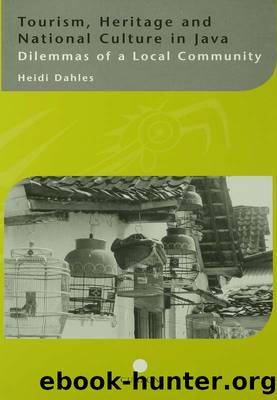Tourism, Heritage and National Culture in Java by Heidi Dahles

Author:Heidi Dahles [Dahles, Heidi]
Language: eng
Format: epub
ISBN: 9781138863408
Barnesnoble:
Publisher: Taylor & Francis
Published: 2015-06-09T00:00:00+00:00
EDUCATING THE STREETSIDE'S WORKFORCE
The âstreetsideâ tourism industry is provided with educated personnel who have graduated from one of the many local tourism schools. Yogyakarta does not have the most prestigious schools in the sector; the top schools are situated in Bandung, Jakarta, and Bali, but there are good schools in Yogyakarta as well.12 The tourism schools, of which eight are accredited, train young people with at least a secondary school (SMA, Sekolah Menengah Atas) certificate to meet the requirements of star-rated tourism. The accredited schools offer three-year programmes at the Diploma III level,13 which have a two-tiered division into Hospitality Training and Tour and Travel Management. Students specialize in one of the two trajectories, and generally the hospitality sector is strongly female dominated while male students prefer the tour and travel business. Most tourism schools have facilities to provide their students with practical training, such as a hotel room, a reception desk, a travel bureau, and a ticket counter. The schools are competing amongst each other for internship contracts and employment opportunities for their graduates. Generally the graduates of the accredited institutes find jobs in the middle management of Yogyanese hotels, travel agencies, airlines and in the government departments of Diparda and KANWIL. They face fierce competition from the many academies and programmes which are of questionable repute and lack the proper accreditation. Many students have to turn to these competitors as the accredited schools apply fixed enrolments, which leaves many young people without a chance of ever getting accepted.14 Sometimes they are preferred because in the face of mounting financial pressures, young people prefer to enrol in short-term programmes. This explains the proliferation of institutes offering tourism education. As a consequence, more and more graduates are entering the market and potential employers lose sight of the quality of the graduates. Networking and close collaboration with ASITA is a crucial advantage if the accredited schools are to be successful in the labour market. However, the competition for jobs in the âbetterâ hotels is already cut throat, and there are indications that graduates either accept a job, start a business in the kampung tourism sector, or enter handicraft production. It seems that tourism education â meant to contribute to the professionalization of the sector â is actually contributing to informalization and de-skilling as well-educated people are prepared to accept jobs beneath their level of training.15
Download
This site does not store any files on its server. We only index and link to content provided by other sites. Please contact the content providers to delete copyright contents if any and email us, we'll remove relevant links or contents immediately.
China Rich Girlfriend by Kwan Kevin(3902)
The Silk Roads by Peter Frankopan(3775)
Annapurna by Maurice Herzog(2846)
Hot Thai Kitchen by Pailin Chongchitnant(2815)
Full Circle by Michael Palin(2780)
Okonomiyaki: Japanese Comfort Food by Saito Yoshio(2391)
City of Djinns: a year in Delhi by William Dalrymple(2139)
The Ogre by Doug Scott(2119)
Photographic Guide to the Birds of Indonesia by Strange Morten;(2091)
Tokyo by Rob Goss(2022)
Vietnam, Cambodia, Laos & Northern Thailand by Lonely Planet(2016)
Tokyo Geek's Guide: Manga, Anime, Gaming, Cosplay, Toys, Idols & More - The Ultimate Guide to Japan's Otaku Culture by Simone Gianni(1949)
Discover China Travel Guide by Lonely Planet(1868)
Everest the Cruel Way by Joe Tasker(1829)
China (Lonely Planet, 11th Edition)(1800)
Lonely Planet China(1758)
China Travel Guide by Lonely Planet(1741)
Top 10 Dubai and Abu Dhabi by DK Travel(1719)
Iranian Rappers And Persian Porn by Maslin Jamie(1713)
